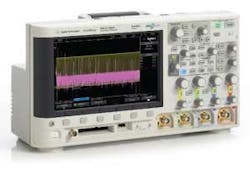Oscilloscopes are all-purpose tools to an engineer, invaluable for their capability to capture a variety of signals whether in the design or troubleshooting stage of a product development. The latest-generation InfiniiVision 2000 and 3000 X-Series mixed-signal and digital-storage oscilloscopes from Agilent Technologies bring new meaning to the term "general-purpose instruments"; their powerful signal-capture capabilities and performance includes waveform update rates as fast as 1 million waveforms per second. Introducing a total of 26 scopes, the firm's new InfiniiVision 2000 X-Series oscilloscopes are available in bandwidths from 70 to 200 MHz, while the latest InfiniiVision 3000 X-Series scope models cover bandwidths from 100 to 500 MHz. Both series include mixed-signal oscilloscopes (MSOs), as well as digital-storage oscilloscopes (DSOs) with two or four analog channels.
The InfiniiVision 2000 X-Series in-cludes DSOs and MSOs with bandwidths of 70, 100, and 200 MHz operating at a sampling rate of 1 GSamples/s per channel. A DSO with two or four analog channels can be upgraded at any time to an optional MSO with eight integrated digital channels and digital timing analysis capability. Both forms of the instruments offer 100 kpoints of memory and waveform update rates to 50,000 waveforms/s. They feature a 8.5-in. WVGA display screen with 800 x 480 pixel resolution and built-in USB host and device ports for ease of connectivity with a personal computer and in a network. Nonvolatile reference waveform memory allows two waveforms to be stored as reference signals where they can be used for comparison with live waveforms. In addition, the waveform memory can be segmented, making it easier to manage the use of memory for low-duty-cycle signals, such as radar pulses. The InfiniiVision 2000 X-Series scopes provide 23 automated measurements, such as voltage, time, and frequency measurements, along with waveform math functions. A hardware-accelerated mask-testing option can also simplify automated measurements, while an optional 20-MHz waveform generator can be used to produce different stimulus signals, including sine, square, ramp, pulse, and noise waveforms.
The InfiniiVision 3000 X-Series scopes (Fig. 1) are available as DSOs and optional MSOs with 16 logic channels. These instruments are available with two or four analog channels with bandwidths of 100, 200, 350, and 500 MHz. They operate at 2 GSamples/s per channel and are equipped with 2 Mpoints of waveform memory standard and 4 Mpoints of waveform memory as an option. These are the high-speed instruments, capable of updating at rates to 1 million waveforms/s. They also offer an optional 20-MHz waveform generator, optional hardware-accelerated serial protocol analysis, and show results on a bright 8.5-in. WVGA display screen.
Both families of instruments benefit from a powerful custom 6-million-gate, application-specific integrated circuit (ASIC) fabricated with a 90-nm silicon CMOS semiconductor process (Fig. 2). The InfiniiVision X-Series models weigh 4 lbs. and are about 15 in. wide by 6 in. deep. Upgrades are available not only for features and functions, but for bandwidth as well.
About the Author
Jack Browne
Technical Contributor
Jack Browne, Technical Contributor, has worked in technical publishing for over 30 years. He managed the content and production of three technical journals while at the American Institute of Physics, including Medical Physics and the Journal of Vacuum Science & Technology. He has been a Publisher and Editor for Penton Media, started the firm’s Wireless Symposium & Exhibition trade show in 1993, and currently serves as Technical Contributor for that company's Microwaves & RF magazine. Browne, who holds a BS in Mathematics from City College of New York and BA degrees in English and Philosophy from Fordham University, is a member of the IEEE.
